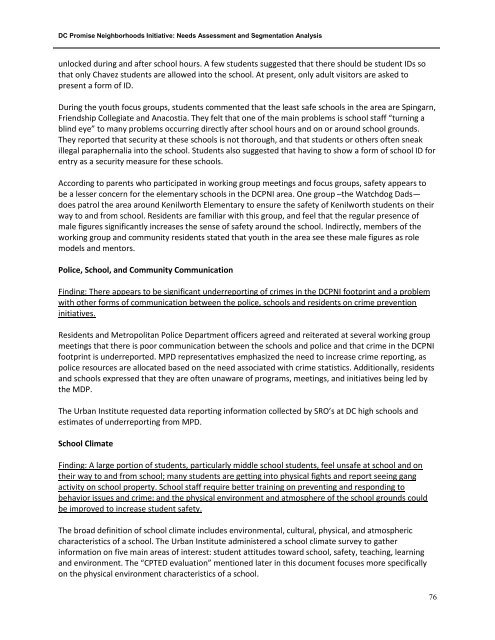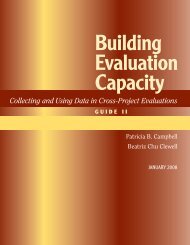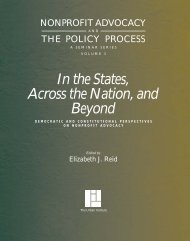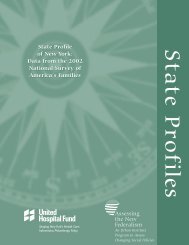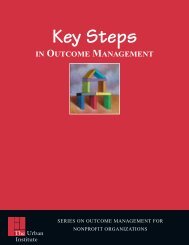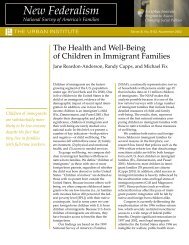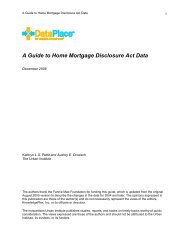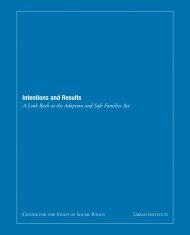DC Promise Neighborhood Initiative: Needs ... - Urban Institute
DC Promise Neighborhood Initiative: Needs ... - Urban Institute
DC Promise Neighborhood Initiative: Needs ... - Urban Institute
Create successful ePaper yourself
Turn your PDF publications into a flip-book with our unique Google optimized e-Paper software.
<strong>DC</strong> <strong>Promise</strong> <strong>Neighborhood</strong>s <strong>Initiative</strong>: <strong>Needs</strong> Assessment and Segmentation Analysisunlocked during and after school hours. A few students suggested that there should be student IDs sothat only Chavez students are allowed into the school. At present, only adult visitors are asked topresent a form of ID.During the youth focus groups, students commented that the least safe schools in the area are Spingarn,Friendship Collegiate and Anacostia. They felt that one of the main problems is school staff “turning ablind eye” to many problems occurring directly after school hours and on or around school grounds.They reported that security at these schools is not thorough, and that students or others often sneakillegal paraphernalia into the school. Students also suggested that having to show a form of school ID forentry as a security measure for these schools.According to parents who participated in working group meetings and focus groups, safety appears tobe a lesser concern for the elementary schools in the <strong>DC</strong>PNI area. One group –the Watchdog Dads—does patrol the area around Kenilworth Elementary to ensure the safety of Kenilworth students on theirway to and from school. Residents are familiar with this group, and feel that the regular presence ofmale figures significantly increases the sense of safety around the school. Indirectly, members of theworking group and community residents stated that youth in the area see these male figures as rolemodels and mentors.Police, School, and Community CommunicationFinding: There appears to be significant underreporting of crimes in the <strong>DC</strong>PNI footprint and a problemwith other forms of communication between the police, schools and residents on crime preventioninitiatives.Residents and Metropolitan Police Department officers agreed and reiterated at several working groupmeetings that there is poor communication between the schools and police and that crime in the <strong>DC</strong>PNIfootprint is underreported. MPD representatives emphasized the need to increase crime reporting, aspolice resources are allocated based on the need associated with crime statistics. Additionally, residentsand schools expressed that they are often unaware of programs, meetings, and initiatives being led bythe MDP.The <strong>Urban</strong> <strong>Institute</strong> requested data reporting information collected by SRO’s at <strong>DC</strong> high schools andestimates of underreporting from MPD.School ClimateFinding: A large portion of students, particularly middle school students, feel unsafe at school and ontheir way to and from school; many students are getting into physical fights and report seeing gangactivity on school property. School staff require better training on preventing and responding tobehavior issues and crime; and the physical environment and atmosphere of the school grounds couldbe improved to increase student safety.The broad definition of school climate includes environmental, cultural, physical, and atmosphericcharacteristics of a school. The <strong>Urban</strong> <strong>Institute</strong> administered a school climate survey to gatherinformation on five main areas of interest: student attitudes toward school, safety, teaching, learningand environment. The “CPTED evaluation” mentioned later in this document focuses more specificallyon the physical environment characteristics of a school.76


